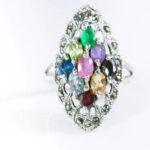Metal beading in jewelry is a timeless art form that has been cherished for centuries. From intricate designs to sleek and minimalist styles, metal beading adds a touch of elegance and sophistication to any piece of jewelry. In this article, we will delve into the world of metal beading, exploring its history, types of metals used, techniques, popular styles and designs, benefits, care tips, DIY projects, and more.
The history of metal beading in jewelry dates back to ancient times when civilizations would adorn themselves with intricately designed pieces made from gold, silver, copper, and other metals. Over the years, this art form has evolved to encompass modern trends while still preserving its traditional beauty. Today, metal beading continues to captivate individuals with its unique aesthetics and craftsmanship.
Whether it’s wire wrapping, soldering, or metal stamping, there are various techniques used in metal beading that allow artisans to create stunning pieces of jewelry. From geometric patterns to bohemian-inspired designs to minimalist styles, the versatility of metal beading offers endless possibilities for creating one-of-a-kind pieces that reflect personal style and creativity. Stay tuned as we explore the world of metal beading in-depth and discover the artistry behind this age-old craft.
History of Metal Beading in Jewelry
The history of metal beading in jewelry dates back to ancient times, where civilizations across the globe utilized various metals to craft intricate and ornate pieces of jewelry. From the Egyptians who adorned themselves with gold and silver beaded jewelry to the Romans who preferred copper and bronze, metal beading has always been a symbol of status, craftsmanship, and artistry.
These early civilizations mastered techniques like wire wrapping and soldering to create stunning pieces that have stood the test of time.
As centuries passed, the art of metal beading in jewelry evolved with changing trends and cultural influences. In the Middle Ages, intricate metal beads were used in religious artifacts, while the Renaissance period saw a resurgence of interest in classical designs and motifs.
The Industrial Revolution brought about mass production of metal beads, making them more accessible to a wider audience. In modern times, metal beading continues to thrive as artisans experiment with new techniques and materials to create innovative styles that cater to contemporary tastes.
Today, metal beading in jewelry encompasses a wide range of metals including gold, silver, copper, brass, and more. Each metal brings its unique characteristics to the design – from the warmth of gold to the cool elegance of silver. Copper is prized for its reddish hue, while brass offers a more affordable alternative with its golden tone. Mixing metals has also become a popular trend, allowing designers to create dynamic contrasts and personalized pieces that reflect individual style preferences.
| Metal | Characteristics |
|---|---|
| Gold | Luxurious and warm tone |
| Silver | Elegant and versatile |
| Copper | Distinct reddish hue |
| Brass | Affordable alternative with golden tone |
Types of Metals Used in Beading
When it comes to metal beading in jewelry, the type of metal used plays a crucial role in determining the overall look and feel of the piece. From ancient civilizations to modern trends, various metals have been utilized in jewelry making, each with its unique properties and characteristics. Gold, silver, copper, and more are some of the common metals that have been favored by artisans for their versatility and aesthetic appeal.
Gold
Gold has been revered for millennia for its beauty and value. In metal beading, gold is often used in its pure form or alloyed with other metals to create different colors and durability. Gold beads can add a touch of luxury and sophistication to any piece of jewelry, making them a popular choice for special occasions or as investment pieces.
Silver
Silver is known for its lustrous shine and affordability, making it a favorite metal for beading in jewelry. Sterling silver, which is an alloy of silver and other metals like copper, is commonly used due to its strength and durability. Silver beads can range from sleek and modern to intricately detailed designs, perfect for both casual wear and formal settings.
Copper
Copper is a versatile metal that has gained popularity in recent years for its warm reddish-brown hue. In metal beading, copper beads can add a rustic and earthy charm to jewelry pieces. Copper is also believed to have health benefits when worn close to the skin, making it not only aesthetically pleasing but also beneficial for the wearer.
Techniques of Metal Beading
Metal beading in jewelry involves various techniques that require skill, creativity, and precision. These techniques not only determine the overall design of the piece but also contribute to its durability and quality. Here are some common techniques used in metal beading:
- Wire Wrapping: Wire wrapping is a popular technique where thin metal wire is used to create intricate designs and patterns. This method allows jewelry makers to twist, coil, and shape the wire into different forms, adding texture and dimension to the piece.
- Soldering: Soldering is a process where two or more metal components are joined together using a filler metal with a high melting point. This technique is commonly used in metal beading to connect different pieces together or add embellishments such as beads or charms.
- Metal Stamping: Metal stamping involves using steel stamps to press designs or patterns onto metal surfaces. This technique is often used to create personalized jewelry pieces by stamping names, dates, or meaningful symbols onto metal beads or pendants.
Each of these techniques requires practice and expertise to master, but they allow jewelry makers to craft unique and custom pieces that showcase their creativity and craftsmanship. Whether you prefer delicate wire-wrapped designs, soldered metals for strength, or stamped details for personalization, exploring these techniques can open up endless possibilities in creating stunning metal beaded jewelry.
Metal beading in jewelry not only offers beauty and style but also durability, versatility, and unique aesthetics. By mastering these techniques, artisans can create timeless pieces that reflect their artistic vision and passion for craftsmanship. Whether you are a beginner looking to learn the basics of metal beading or an experienced jeweler wanting to expand your skills, experimenting with wire wrapping, soldering, and metal stamping can elevate your work to new heights in the world of jewelry design.
Popular Styles and Designs of Metal Beading
When it comes to metal beading in jewelry, there is a wide range of popular styles and designs that cater to different tastes and preferences. One of the timeless choices is geometric patterns, which add a modern and sleek touch to any piece.
Geometric shapes such as triangles, circles, and squares can create a bold statement or a subtle accent, depending on the design. These patterns are often used in earrings, necklaces, and bracelets to give a structured and sophisticated look.
For those who prefer a more eclectic and free-spirited style, Bohemian metal beading might be the perfect choice. Boho-inspired jewelry often features natural elements like beads, feathers, and gemstones combined with metal accents for a rustic yet chic look. The use of mixed metals adds an artistic flair to these pieces, making them perfect for those who appreciate a sense of individuality and creativity in their accessories.
On the other end of the spectrum, minimalist metal beading has gained popularity for its simplicity and understated elegance. Clean lines, simple shapes, and delicate details characterize this style, making it versatile for everyday wear or special occasions. Minimalist metal beaded jewelry pairs well with any outfit due to its classic and timeless appeal. Whether you prefer bold geometric patterns, bohemian flair, or minimalist sophistication, there is a style of metal beading that suits every taste and fashion sense.
Benefits of Metal Beading in Jewelry
Metal beading in jewelry offers a myriad of benefits that make it a popular choice among jewelry enthusiasts. One of the key advantages of using metal beads in jewelry making is their durability.
Unlike other materials, such as plastic or glass, metal beads are sturdy and long-lasting, ensuring that your jewelry pieces will withstand daily wear and tear without losing their luster. Whether you prefer delicate designs or statement pieces, metal beading provides the durability needed for jewelry to stand the test of time.
Another significant benefit of metal beading in jewelry is its versatility. With a wide variety of metals to choose from, including gold, silver, copper, and more, you can create unique and personalized pieces that cater to different styles and preferences.
Whether you opt for a luxurious gold finish or a rustic copper look, metal beading allows for endless possibilities when it comes to designing custom jewelry pieces. Additionally, mixing different metals can add an eclectic touch to your creations, giving them a modern and trendy appeal.
In addition to durability and versatility, metal beading in jewelry also offers unique aesthetics that set it apart from other types of beading materials. The shine and texture of metal beads provide an elegant and sophisticated look to any piece of jewelry.
From intricate wire-wrapped designs to bold metal stamping techniques, the craftsmanship involved in metal beading adds an element of artistry that enhances the overall beauty of the finished product. Whether you prefer geometric patterns or bohemian-inspired styles, incorporating metal beads into your jewelry designs can elevate them to a whole new level of sophistication and elegance.
How to Care for Metal Beaded Jewelry
Metal beaded jewelry is a stunning and popular choice for adding a touch of elegance and sophistication to any outfit. Whether you own gold, silver, copper, or other metal beaded pieces, it’s essential to know how to properly care for them to maintain their beauty and longevity. Cleaning and maintaining metal beaded jewelry not only helps preserve its shine but also ensures that it stays in top condition for years to come.
One of the most common methods for cleaning metal beaded jewelry is using a soft cloth dampened with mild soap and water. Gently wipe down the metal beads, making sure to remove any dirt, oils, or residues that may have accumulated over time.
Avoid using harsh chemicals or abrasive cleaners as they can damage the metal’s finish or any gemstones that may be present in the jewelry. For intricate designs or hard-to-reach areas, you can use a soft-bristled brush to gently scrub the beads.
In addition to regular cleaning, proper maintenance is key to preserving your metal beaded jewelry. Store your pieces in a cool, dry place away from direct sunlight and moisture to prevent tarnishing or discoloration. Avoid exposing your jewelry to harsh chemicals such as perfumes, lotions, or hairsprays as they can affect the metal’s surface.
If your metal beaded jewelry includes gemstones, consider taking them to a professional jeweler for inspection and maintenance periodically. By following these cleaning tips and maintenance practices, you can ensure that your metal beaded jewelry remains radiant and beautiful for years to come.
| Cleaning Tips | Maintenance |
|---|---|
| Use mild soap and water with a soft cloth for cleaning | Store in a cool, dry place away from sunlight |
| Avoid harsh chemicals or abrasive cleaners | Avoid exposure to perfumes, lotions, and hairsprays |
| Gently scrub beads with a soft-bristled brush for intricate designs | Consider professional inspection for gemstone upkeep |
DIY Metal Beading Projects
Creating your own metal beaded jewelry can be a rewarding and creative experience. Whether you are a beginner or an experienced crafter, DIY metal beading projects allow you to express your unique style and personality through handmade accessories. With a few basic tools and materials, you can design and make stunning pieces that reflect your individual taste.
To start, gather the necessary supplies for your metal beading project. This typically includes metal beads in various shapes and sizes, jewelry wire, clasps, jump rings, pliers, wire cutters, and any additional embellishments you wish to incorporate into your design. Consider the color scheme and overall aesthetic you want to achieve before selecting your materials.
One of the most common techniques used in DIY metal beading projects is wire wrapping. This involves securing beads onto wire by creating loops or twists to hold them in place. Soldering is another technique that allows for more intricate designs by fusing metal components together using a soldering iron.
Metal stamping is also popular for adding personalized touches to jewelry pieces by imprinting names, dates, or meaningful symbols onto metal charms or pendants. Experiment with different techniques to discover what works best for your desired outcome.
Whether you prefer bold statement pieces or delicate everyday accessories, there are endless possibilities when it comes to creating metal beaded jewelry. From simple bracelets and earrings to elaborate necklaces and rings, let your imagination guide you as you embark on your DIY metal beading projects. Enjoy the process of designing and crafting one-of-a-kind pieces that showcase the beauty and artistry of metal beading in jewelry.
Conclusion
In conclusion, the artistry and craftsmanship of metal beading in jewelry truly showcases the intricate beauty of this timeless technique. From ancient times to modern trends, metal beading has evolved into a versatile art form that can be seen in various styles and designs, such as geometric patterns, bohemian aesthetics, and minimalist creations.
The use of metals like gold, silver, and copper adds a touch of luxury and elegance to any piece of jewelry, making it a staple in many fashion enthusiasts’ collections.
One of the key benefits of metal beading in jewelry is its durability and longevity. When properly cared for, metal beaded jewelry can last for generations, becoming cherished heirlooms passed down through families. Additionally, the versatility of metal beading allows for endless creativity in design, whether through wire wrapping, soldering, or metal stamping techniques. This uniqueness enhances the overall aesthetic appeal of each piece, making it a special addition to any outfit or occasion.
For those looking to explore their creative side or expand their jewelry collection, embarking on DIY metal beading projects can be a rewarding endeavor. With a step-by-step guide and some basic tools and materials, anyone can create their own personalized metal beaded jewelry pieces.
Whether you are new to the world of metal beading or a seasoned artisan, there is always more to learn and discover about this captivating art form that has stood the test of time. Embrace the artistry and craftsmanship of metal beading in jewelry-it is truly a testament to human creativity and ingenuity.
Frequently Asked Questions
What Is Beading in Jewelry?
Beading in jewelry refers to the process of stringing small beads together using various techniques like threading, wirework, or knotting. It is a popular craft that allows for creativity and customization in designing unique pieces.
Do Metal Beads Tarnish?
Yes, metal beads can tarnish depending on the type of metal used. For example, sterling silver and copper beads are prone to tarnishing over time when exposed to air and moisture. Regular cleaning and storing them properly can help prevent tarnish.
What Are Metal Beads Used For?
Metal beads are versatile components used in jewelry making for adding texture, color, and visual interest to designs. They can be incorporated into necklaces, bracelets, earrings, and other accessories to create striking accents or focal points in the finished piece. Additionally, metal beads come in various shapes, sizes, finishes, and styles to suit different design aesthetics and preferences.

Welcome to my jewelry blog! My name is Sarah and I am the owner of this blog.
I love making jewelry and sharing my creations with others.
So whether you’re someone who loves wearing jewelry yourself or simply enjoys learning about it, be sure to check out my blog for insightful posts on everything related to this exciting topic!





